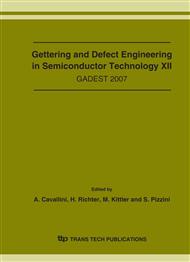p.289
p.293
p.303
p.309
p.315
p.321
p.327
p.333
p.339
The Temperature Evolution of the Hydrogen Plasma Induced Structural Defects in Crystalline Silicon
Abstract:
Hydrogenated n and p doped Czochralski Si substrates have been studied by means of atomic force microscopy, scanning and transmission electron microscopy, Raman spectroscopy and microwave photoconductivity decay techniques. The measurements show that the surface is roughest in ndoped samples which are plasma treated at high frequency. The cone density was found to be highest on p-doped samples, which correlates well to the higher density of defects observed in pdoped samples. The surface cones were found to consist of nanograins, twins and stacking faults with random orientations, several hydrogen induced defects and bubbles. The size, density and formation depth of the subsurface defects were seen to depend on doping type, doping level, plasma frequency and hydrogenation time. Raman spectroscopy shows formation of nearly free hydrogen molecules, which are presumed to be located in nano-voids or platelets. These molecules dissolved at temperatures around 600°C. By means of the &-PCD measurements, it is demonstrated that hydrogen-initiated structural defects act as active recombination centres, which are responsible for the degradation of the minority carrier lifetime.
Info:
Periodical:
Pages:
315-320
Citation:
Online since:
October 2007
Price:
Сopyright:
© 2008 Trans Tech Publications Ltd. All Rights Reserved
Share:
Citation:


